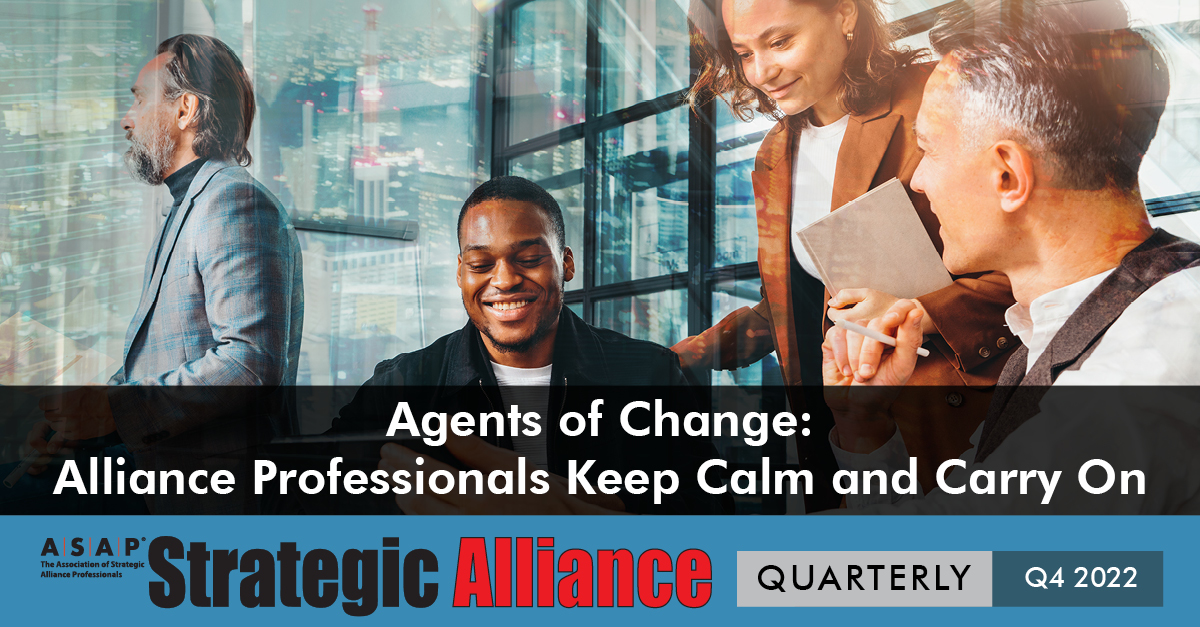Agents of Change: Alliance Professionals Keep Calm and Carry On
In some of my interviews for a recent Strategic Alliance Quarterly article on biopharma and digital health partnering, “Crossing the Divide” (Q4 2022), I asked this question: Isn’t one of the unspoken themes that we’re all thinking very differently now about what healthcare actually could be—or should be? So isn’t this story—at least in part—about the transformation of healthcare, and how alliance professionals will need to respond?
The answer from Alex Waldron, CEO of Wellinks, was “Absolutely.” Several others echoed that view, mentioning Covid-19 as a catalyst for this ongoing transformation. Before the pandemic, how many of us would have considered having a Zoom call with our physician or therapist? How many of us would have thought that using a smartphone app to manage our COPD, cardiovascular disease, diabetes, or even our weight was a viable option? Or that we could employ virtual reality to ameliorate our symptoms of depression?
Not many of us, I’d bet. We would have felt “awkward,” as Waldron put it, and those solutions wouldn’t have seemed “real” or “legitimate”—even though the technologies had already been around for some time.
“You’ve got this world now where people are able to access healthcare in a way they never could have before, you have the willingness to use technology in a way they never had before, so [Covid] really accelerated the ability to connect the provider and patient, but it also [allowed] those companies that were actively monitoring and treating diseases to do so in a much more progressive fashion,” Waldron told me.
When Worlds Collide, the Profession Gets Busy
Change can be good, especially when it means greater access to healthcare—for more of the people, more of the time. But it requires us to make some adjustments. The last article I wrote about the convergence of healthcare, tech, and retail, “When Worlds Collide” (Strategic Alliance Quarterly, Q3 2021), included a section headed “The Doctor Won’t See You Now—but Walmart Will.”
The phenomenon it described has become commonplace. Not only Walmart, but Walgreens, CVS, Amazon, and likely your local supermarket have gotten into the business of providing healthcare—not just ibuprofen and nasal sprays you can grab off the shelves, but actual medical treatments via their in-store clinics. They’re on the fast track to making the old doctor’s waiting room, with its endless wait times and musty back issues of Reader’s Digest, about as relevant as the milkman.
But healthcare isn’t all that’s changed. Other industries are transforming while we watch, from the automotive industry to information technology to manufacturing to energy to chemicals.
Work-Life Balance? What’s That?
Even work itself has been remade. Pre-pandemic, how many workers were told there was no way they could do their jobs from home? Then Covid arrived, and it became abundantly clear that many jobs can be done remotely, and pretty well at that. With the widespread return to offices, there’s a push for employees to be able to work one or two days from home and the rest at the office. This trend not only balances home and work life better, but also balances between potentially isolating at home—if attempting to work amid the hubbub of kids, pets, and spouses counts as “isolation”—versus being back in-person with all the watercooler conversations and hallway meetings. (Some recent studies, meanwhile, have concluded that working in the office doesn’t actually lead to greater creativity or innovation than work-from-home. Darn it! Another myth exploded!)
The only good reason for reforming, reinventing, or remaking anything—be it healthcare, technology, industry, or workplace norms—is to make it work better for people. Most of the people, most of the time. And for expertise in the area of transformation and change, perhaps we need look no further than alliance professionals.
Communication, Facilitation, Orchestration…All in a Day’s Work
Because whatever the change is, as Aida Bendt of AstraZeneca noted in another interview, alliance managers are the “change agents.” Typically they’re not initiating the change, but they’re the ones who must keep calm and carry on, communicating with both internal and external audiences and explaining the implications of what’s happening. Then they figure out what to do about it—whether it’s a “good” change like a drug approval or a more “negative” change like alliance failure and termination.
They’re the proactive facilitators of key action items. They’re the conveners who get the right people in the room together to make decisions. They’re the bridge between partners—between what’s going on “out there” and what needs to happen “in here.” They help cushion the blow from the buffeting external winds of change and the sudden storms and shocks from volatile markets, disrupted industries, societal shifts, and more. Sometimes they even “hear” things coming before anyone else does, because they’re so plugged in to what’s happening with their partners’ businesses, and beyond.
Change agents, communicators, explainers, interpreters, calmers-down, partner whisperers, conflict managers, orchestrators, business strategists… That might be just the beginning of a rather inadequate job description for alliance professionals.
But it’s at least a start. And it’s a lot!
A version of this post originally appeared as “The Close” in the Q4 2022 issue of Strategic Alliance Quarterly.

